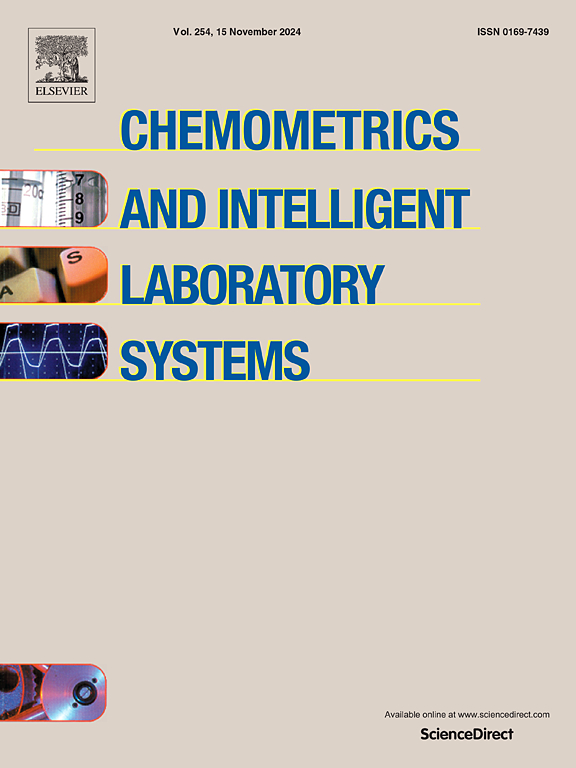基于卡尔曼滤波技术的即时光谱非混频技术
IF 3.7
2区 化学
Q2 AUTOMATION & CONTROL SYSTEMS
Chemometrics and Intelligent Laboratory Systems
Pub Date : 2024-10-30
DOI:10.1016/j.chemolab.2024.105252
引用次数: 0
摘要
这项工作介绍了一种即时(即在线)线性光谱解混合方法,该方法能够按频谱逐一顺序分析获取的光谱数据。在推导出传统线性混频模型的顺序对应模型后,所提出的方法将线性解混问题重铸为线性状态空间估计框架。在高斯噪声和状态模型下,通过卡尔曼滤波可以有效地估计纯光谱。有趣的是,卡尔曼滤波可以在低维子空间中运行,从而减轻整个解混频过程的计算负担。在合成和真实拉曼数据集上获得的实验结果表明,这种基于卡尔曼滤波器的方法可以在解混合精度和计算效率之间进行方便的权衡,而计算效率对于在实时环境中运行至关重要。所提出的方法是一个有价值的构件,可从最近在显微镜文献中提出的采集和处理框架中获益,这些框架的动机是减少采集时间和避免对光敏样品造成潜在损害等实际问题。本文报告的数值图解相关代码可在 https://github.com/HKouakou/KF-OSU 免费在线获取。本文章由计算机程序翻译,如有差异,请以英文原文为准。
On-the-fly spectral unmixing based on Kalman filtering
This work introduces an on-the-fly (i.e., online) linear spectral unmixing method which is able to sequentially analyze spectral data acquired on a spectrum-by-spectrum basis. After deriving a sequential counterpart of the conventional linear mixing model, the proposed approach recasts the linear unmixing problem into a linear state-space estimation framework. Under Gaussian noise and state models, the estimation of the pure spectra can be efficiently conducted by resorting to Kalman filtering. Interestingly, it is shown that this Kalman filter can operate in a lower-dimensional subspace to lighten the computational burden of the overall unmixing procedure. Experimental results obtained on synthetic and real Raman data sets show that this Kalman filter-based method offers a convenient trade-off between unmixing accuracy and computational efficiency, which is crucial for operating in an on-the-fly setting. The proposed method constitutes a valuable building block for benefiting from acquisition and processing frameworks recently proposed in the microscopy literature, which are motivated by practical issues such as reducing acquisition time and avoiding potential damages being inflicted to photosensitive samples. The code associated with the numerical illustrations reported in this paper is freely available online at https://github.com/HKouakou/KF-OSU.
求助全文
通过发布文献求助,成功后即可免费获取论文全文。
去求助
来源期刊
CiteScore
7.50
自引率
7.70%
发文量
169
审稿时长
3.4 months
期刊介绍:
Chemometrics and Intelligent Laboratory Systems publishes original research papers, short communications, reviews, tutorials and Original Software Publications reporting on development of novel statistical, mathematical, or computer techniques in Chemistry and related disciplines.
Chemometrics is the chemical discipline that uses mathematical and statistical methods to design or select optimal procedures and experiments, and to provide maximum chemical information by analysing chemical data.
The journal deals with the following topics:
1) Development of new statistical, mathematical and chemometrical methods for Chemistry and related fields (Environmental Chemistry, Biochemistry, Toxicology, System Biology, -Omics, etc.)
2) Novel applications of chemometrics to all branches of Chemistry and related fields (typical domains of interest are: process data analysis, experimental design, data mining, signal processing, supervised modelling, decision making, robust statistics, mixture analysis, multivariate calibration etc.) Routine applications of established chemometrical techniques will not be considered.
3) Development of new software that provides novel tools or truly advances the use of chemometrical methods.
4) Well characterized data sets to test performance for the new methods and software.
The journal complies with International Committee of Medical Journal Editors'' Uniform requirements for manuscripts.

 求助内容:
求助内容: 应助结果提醒方式:
应助结果提醒方式:


